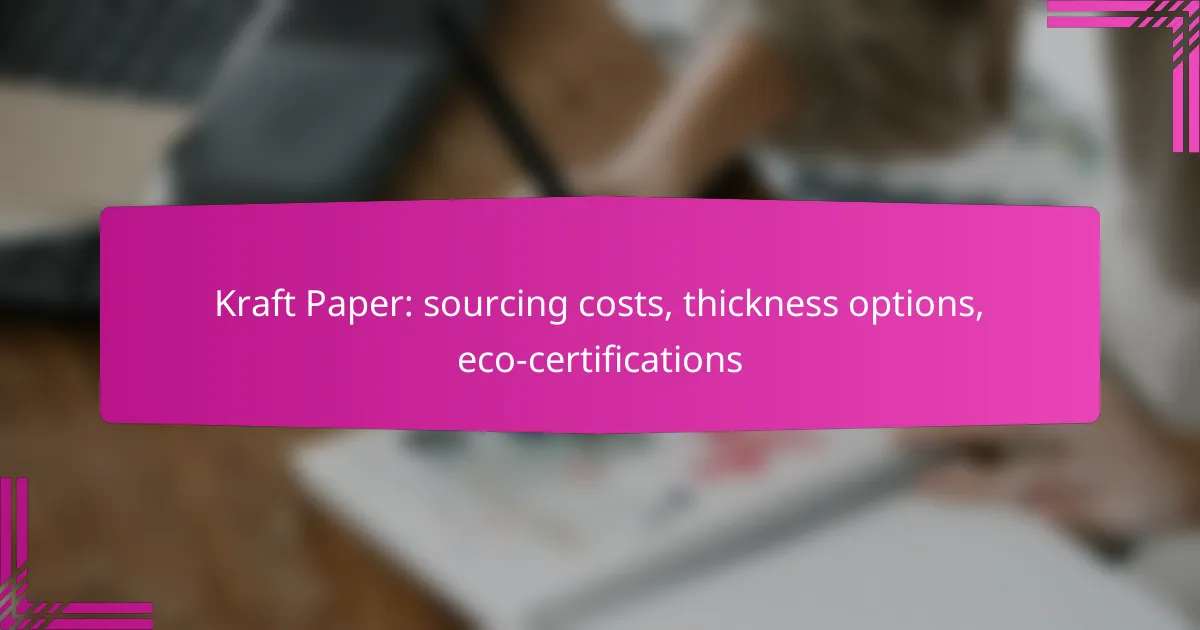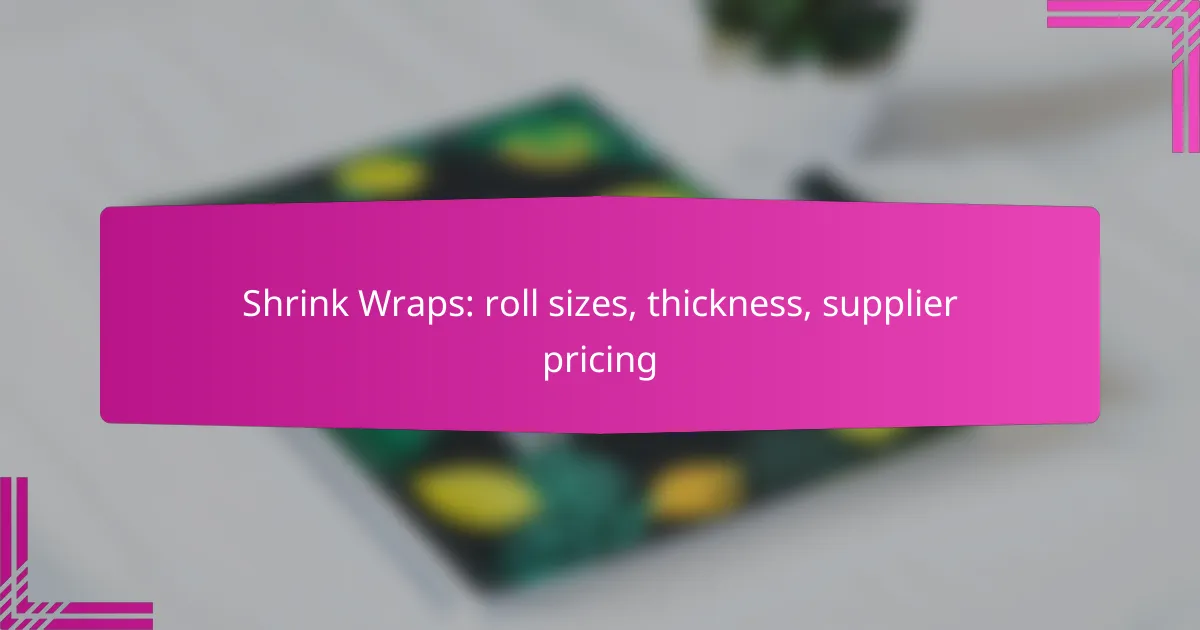Kraft paper is a versatile material with sourcing costs that can vary widely based on thickness, supplier, and order size, typically ranging from moderate to high. Available in various thickness options, measured in grams per square meter (gsm) or mils, the choice of thickness influences the paper’s strength and suitability for different applications. When sourcing Kraft paper, it is essential to consider eco-certifications like FSC and PEFC, which ensure sustainable practices and environmental responsibility.
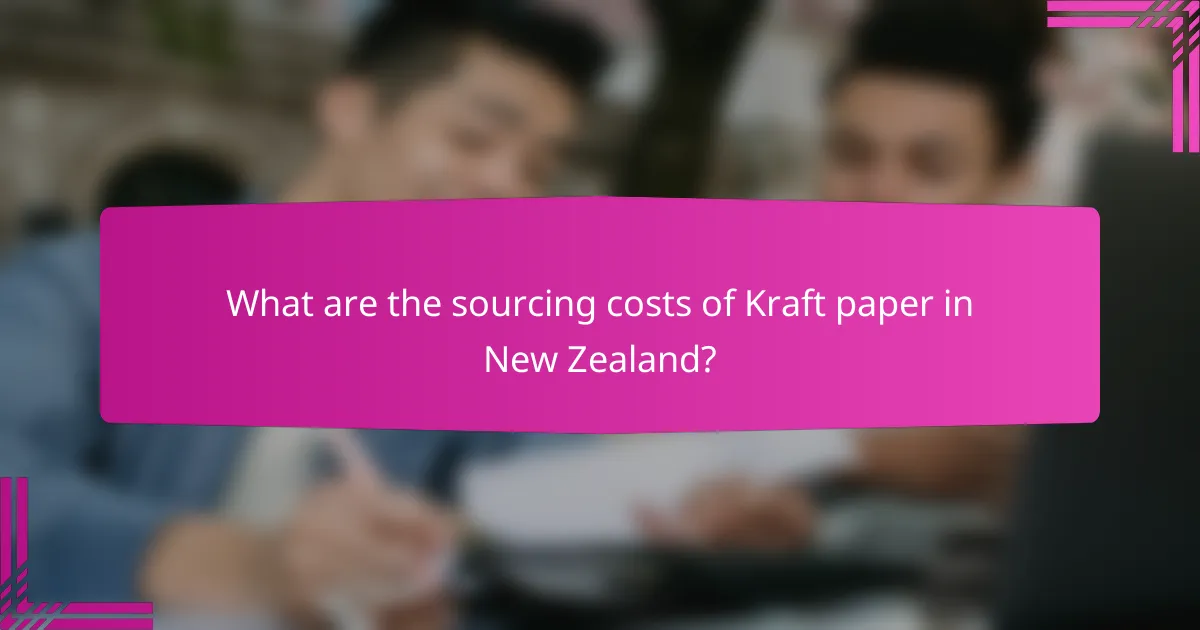
What are the sourcing costs of Kraft paper in New Zealand?
The sourcing costs of Kraft paper in New Zealand can vary significantly based on several factors, including thickness, supplier, and order size. Generally, prices can range from moderate to high, influenced by market demand and material quality.
Average price per ton
The average price per ton of Kraft paper in New Zealand typically falls within the range of NZD 1,000 to NZD 1,500. Prices can fluctuate based on the type of Kraft paper, such as unbleached or bleached, and the specific properties required for different applications.
Factors influencing costs
Several factors influence the costs of Kraft paper, including raw material availability, production methods, and environmental regulations. For instance, sustainable sourcing practices may increase costs due to certification processes and higher-quality materials.
Additionally, market demand can affect pricing; during peak seasons, prices may rise due to increased orders from industries such as packaging and construction.
Supplier comparisons
When comparing suppliers, it’s essential to consider not only price but also quality and service. Some suppliers may offer lower prices but compromise on material quality or delivery times, while others may provide premium products with better customer support.
Researching multiple suppliers and requesting samples can help ensure that you choose the best option for your needs, balancing cost with quality.
Bulk purchase discounts
Bulk purchases of Kraft paper often come with significant discounts, making it cost-effective for businesses that require large quantities. Discounts can range from 5% to 15% or more, depending on the supplier and order size.
It’s advisable to negotiate terms with suppliers, as they may offer additional savings for long-term contracts or repeat orders.
Shipping and handling fees
Shipping and handling fees can add to the overall sourcing costs of Kraft paper. These fees vary based on the supplier’s location, the distance to your business, and the volume of the order.
To minimize shipping costs, consider local suppliers or those that offer free shipping for larger orders. Always factor these fees into your total budget when sourcing Kraft paper.
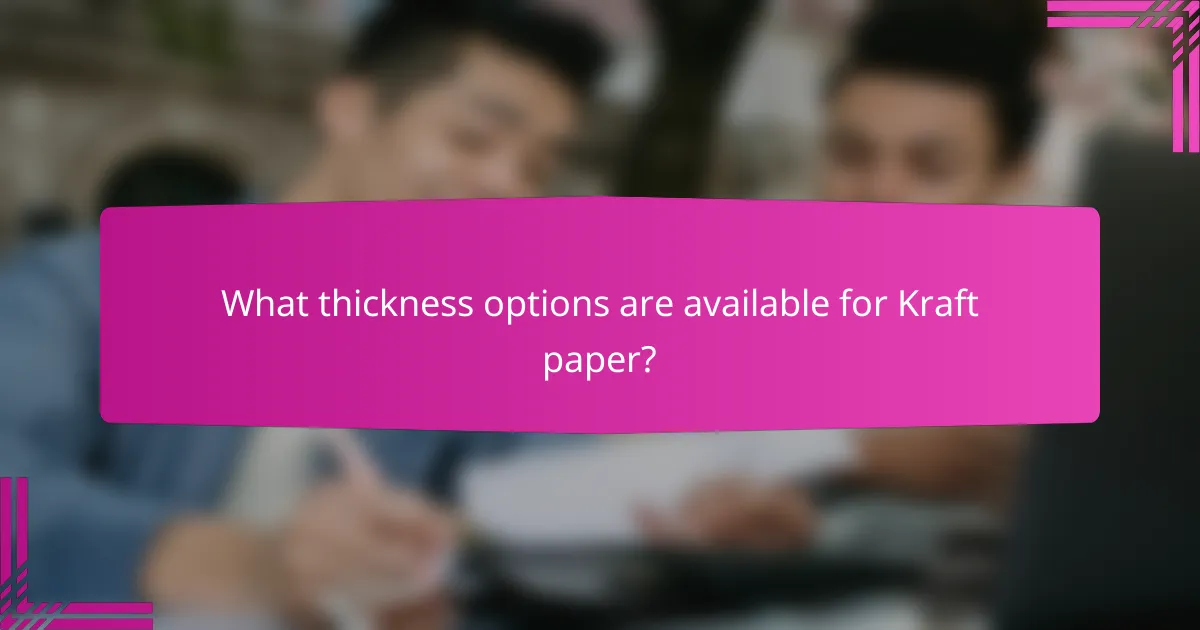
What thickness options are available for Kraft paper?
Kraft paper comes in various thickness options, typically measured in grams per square meter (gsm) or mils. The choice of thickness affects the paper’s strength, durability, and suitability for different applications.
Common thickness ranges
Kraft paper thickness generally ranges from about 30 gsm to 300 gsm. Thinner papers, around 30-80 gsm, are often used for wrapping and packaging, while thicker options, such as 100-300 gsm, are suitable for more demanding applications like bags and boxes.
In terms of mils, Kraft paper can vary from approximately 3 mils for lightweight varieties to over 12 mils for heavy-duty options. Understanding these ranges helps in selecting the right paper for specific needs.
Applications for different thicknesses
Thinner Kraft paper (30-80 gsm) is ideal for lightweight packaging, such as wrapping gifts or food items. It is also commonly used for arts and crafts due to its flexibility and ease of use.
Medium thickness (100-200 gsm) is often employed for shopping bags, envelopes, and protective packaging. Heavier Kraft paper (200-300 gsm) is typically used for industrial applications, such as shipping containers and durable bags, where strength is crucial.
Comparative analysis of thickness types
When comparing thickness types, consider the trade-offs between weight and durability. Thinner papers are more economical and easier to handle but may not provide the necessary strength for heavy items.
Conversely, thicker Kraft paper offers greater durability but can be more expensive and less flexible. Assessing the specific requirements of your project, such as weight capacity and cost, will guide you in choosing the appropriate thickness.
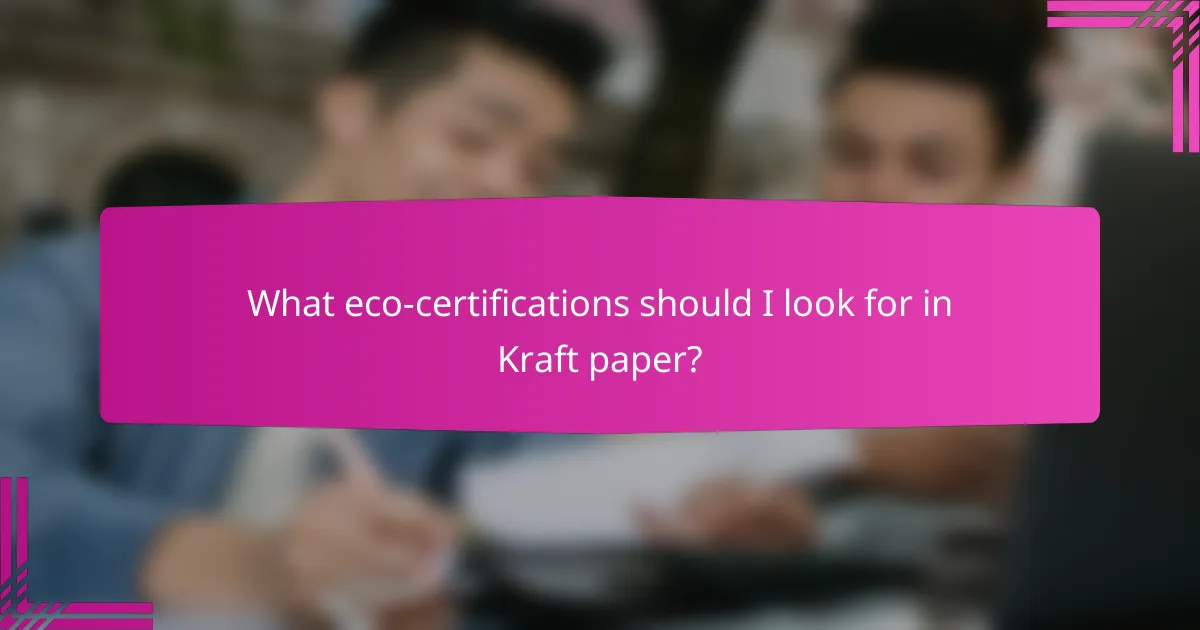
What eco-certifications should I look for in Kraft paper?
When sourcing Kraft paper, look for eco-certifications that indicate sustainable practices and environmental responsibility. Key certifications include FSC and PEFC, which ensure that the paper comes from responsibly managed forests, as well as standards for recyclability and compostability.
FSC certification details
The Forest Stewardship Council (FSC) certification guarantees that the Kraft paper is sourced from forests that are managed sustainably. This means that the harvesting of trees does not harm the ecosystem and supports the local community. FSC-certified products often carry a label that helps consumers identify environmentally friendly options.
When purchasing, check for the FSC logo on the packaging. This certification is recognized globally and is a reliable indicator of responsible forestry practices.
PEFC certification significance
The Programme for the Endorsement of Forest Certification (PEFC) is another important certification for Kraft paper. It focuses on promoting sustainable forest management through a multi-stakeholder approach, ensuring that the paper is sourced from forests that are managed in accordance with strict environmental and social standards.
PEFC certification is particularly significant in Europe and is gaining recognition worldwide. Look for PEFC labels to ensure that your Kraft paper supports sustainable forestry practices.
Recyclability and compostability standards
Recyclability and compostability are crucial factors in evaluating the environmental impact of Kraft paper. Recyclable Kraft paper can be processed and reused in the paper-making cycle, reducing waste and conserving resources. Compostable Kraft paper breaks down naturally, returning nutrients to the soil.
Check for certifications like the Recycling Symbol or the Compostable logo when sourcing Kraft paper. These indicators help ensure that the paper meets industry standards for environmental sustainability.

How do sourcing costs vary by supplier in New Zealand?
Sourcing costs for kraft paper in New Zealand can differ significantly based on the supplier’s location, production methods, and material quality. Local suppliers may offer competitive pricing but could have limited stock, while international suppliers might provide a broader range but include shipping costs and tariffs.
Local vs international suppliers
Local suppliers often provide faster delivery times and lower shipping costs, making them a practical choice for businesses needing quick access to kraft paper. However, their prices may be higher due to smaller production scales and limited availability.
International suppliers can offer lower prices due to economies of scale and a wider selection of thickness options. Nevertheless, businesses must consider additional costs such as shipping fees, import duties, and longer lead times, which can affect overall sourcing costs.
Price trends over time
Over the past few years, the prices of kraft paper have fluctuated due to changes in raw material costs, demand, and global supply chain disruptions. Generally, prices have seen a gradual increase, particularly during periods of high demand or material shortages.
To navigate these trends, businesses should monitor market conditions and consider locking in prices with suppliers when favorable rates are available. Additionally, exploring bulk purchasing options can help mitigate cost increases over time.

What are the environmental impacts of Kraft paper production?
Kraft paper production has significant environmental impacts, primarily related to its carbon emissions and water consumption. Understanding these factors is crucial for assessing the sustainability of Kraft paper and making informed sourcing decisions.
Carbon footprint analysis
The carbon footprint of Kraft paper production can vary widely based on the manufacturing process and energy sources used. Generally, the process emits several hundred kilograms of CO2 per ton of paper produced. Switching to renewable energy sources can significantly reduce these emissions.
When evaluating suppliers, consider those who utilize energy-efficient technologies or renewable energy. Certifications like ISO 14001 can indicate a commitment to reducing environmental impact.
Water usage statistics
Kraft paper production is water-intensive, often requiring thousands of liters of water per ton of paper. This water is primarily used for pulping and washing processes. Regions with strict water regulations may impose limits on water usage, affecting production costs.
To mitigate water impact, look for suppliers who implement water recycling systems or adhere to standards like the Water Stewardship Standard. This can help ensure sustainable water management practices are in place.

How can I choose the right Kraft paper for my needs?
Choosing the right Kraft paper involves considering its thickness, sourcing costs, and eco-certifications. Assess your specific requirements based on the intended use, budget, and environmental impact to make an informed decision.
Sourcing costs of Kraft paper
Sourcing costs for Kraft paper can vary significantly based on factors such as quality, thickness, and supplier. Generally, prices range from a few cents to several dollars per square meter, depending on these variables.
When sourcing, consider bulk purchasing options, which may offer discounts. Additionally, local suppliers may provide better shipping rates and lower overall costs compared to international sources.
Thickness options for Kraft paper
Kraft paper is available in various thicknesses, typically measured in grams per square meter (gsm). Common thicknesses range from 40 gsm for lightweight applications to over 300 gsm for heavy-duty uses.
For packaging, a thickness of 70-120 gsm is often suitable, while thicker options are better for structural applications. Always match the thickness to your specific needs to ensure durability and functionality.
Eco-certifications for Kraft paper
Eco-certifications for Kraft paper indicate its environmental sustainability. Look for certifications such as FSC (Forest Stewardship Council) or PEFC (Programme for the Endorsement of Forest Certification), which ensure responsible sourcing practices.
Choosing certified Kraft paper not only supports sustainable forestry but can also enhance your brand’s reputation. Be sure to verify the certifications with your supplier to ensure authenticity.
